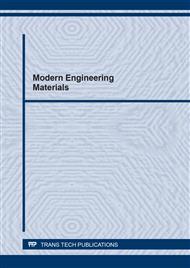p.3
p.9
p.15
p.21
p.29
p.35
p.41
p.47
p.55
Localized Corrosion Susceptibility of 434 Ferritic Stainless Steel in Acid Chloride Media
Abstract:
The pitting corrosion resilience and passivation behaviour of 434 ferritic stainless steel was studied in 1 M H2SO4 solution at 0% to 2% NaCl concentration by potentiostatic technique and optical illustration characterization. Data showed 434 steel underwent metastable pitting activity at the lowest metastable pitting potential and current by reason of the effect of SO42- anions within the electrolyte. Addition and increase in Cl- anion concentration decreased the potential while simultaneously increasing the current value at which metastable pitting occurs till 1% NaCl concentration. The presence of chlorides decreased the passivation range of the steel with regards to Cl- anion concentration compared to the electrolyte without chlorides till 0.5% NaCl concentration. Beyond this concentration no further decrease in the steel’s passivation range was observed despite increase in chloride concentration. Beyond 1% NaCl concentration passivation of the steel completely collapsed signifying threshold chloride concentration for optimal steel utilization on astringent conditions. Potentiostatic data showed variation in chloride concentration from 0.25% to 1% had strong effect on the pitting resistance of 434 steel. Optical images of 434 steel morphology at 0%, 0.25% and 2% NaCl concentration in 1 M H2SO4 solution showed important details. At 0% and 0.25% NaCl concentration, corrosion pits were clearly visible though the dimension and depth of the pits from the electrolyte with 0.25% NaCl concentration were more defined and deeper. At 2% NaCl concentration, corrosion pits were larger and the surface morphology showed severe morphological deterioration by reason of the synergistic action of SO42- and excess Cl- anions.
Info:
Periodical:
Pages:
29-34
Citation:
Online since:
April 2022
Authors:
Price:
Сopyright:
© 2022 Trans Tech Publications Ltd. All Rights Reserved
Share:
Citation:


